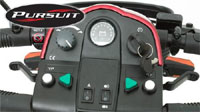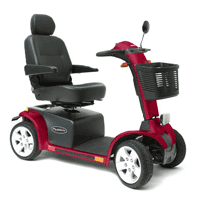Mobility scooters and electric wheelchairs are two different types of mobility solutions with specific features that meet the needs of different individuals. Before determining whether or not a mobility scooter is the best solution for your needs, you and your physician or physical therapist will have to assess your abilities and the environment you’ll be using the scooter in. For example, a mobility scooter will typically not be as nimble as a power wheelchair so operating it in tighter quarters may be difficult for some. Scooters also require a bit more upper body strength and balance in order for the user to manipulate the tiller or handles of the scooter. Forward and reverse is typically operated by thumb levers that are set in the tiller, so you’ll have to have enough dexterity in your thumbs to operate it. If you require outdoor mobility, you’ll probably prefer the freedom, speed, range, and versatility of a scooter. Once again, your needs will ultimately determine the type of mobility device that is best for you. Be sure to check our mobility scooter reviews section where users rate and review a selection of electric scooters.
Types of Mobility Scooters
Once you have settled on a scooter for your mobility needs, you’ll now have to dig a bit deeper and get even more specific on how you’ll be using the device. Some scooter models are better at certain tasks than others and are even built for specific functionality. Will you be taking your scooter on vacation? Where will you be storing your device? How even is the terrain you’ll be traveling on? These are all great questions that, believe it or not, have a specific scooter solution. You may even want multiple scooters for different circumstances.
3 Wheeled Mobility Scooters – These types of power scooters are the most maneuverable and have the tightest turning radius. They are ideal for riders who must operate in tight spaces. Their high turning radii allow them to navigate just about anything and make turns most 4 wheeled scooters can’t. If you prefer to use a scooter in your home or apartment this would be your best option. 3 wheel scooters are great for light outdoor use. Keeping them on even terrain is probably a good idea.
4 Wheeled Mobility Scooters – Designed more for stability and less for maneuverability. Not as good for tighter quarters but great for outdoor use. 4 wheel scooters were specifically designed to tackle tougher, uneven terrain and can go off-road if necessary. If you require a little more balance or have difficulty maneuvering a 3 wheeled scooter, this may be a better option for you. 4 wheeled scooters are the heaviest scooter option so traveling with them will often prove to be difficult without a powered lift.
Travel Scooters – (aka compact/folding scooters) are designed for travel. Their compact design gives users the ability to take their scooters with them on vacation. Many travel models can be dis-assembled and stowed in a trunk or checked as baggage on an airplane/cruise ship. Their light weight is ideal for portability and travel but will ultimately decrease their inherent balance for the user. This type of scooter has a definitive weight limit. Make sure to verify the limit in the user manual or with your supplier.
Mobility Scooter Components
The modern mobility scooter has developed over the years. Many features have changed and improved but most models typically share a common framework and characteristics.
The Base of your mobility scooter will typically dictate how it will be used. Most mobility scooters have a rear wheel drive design that is made to deliver speed, range, stability, and a higher weight capacity. Front wheel drive scooters are designed for indoor, light use on flat surfaces and terrain. They generally offer excellent maneuverability as well as portability. From our observations it appears most major scooter manufacturers offer a limited number of front wheel drive models (if any). We’ve only seen a few travel models that are still offered in the current online mobility marketplace. Scooters made for travel will typically be manufactured with lighter materials like aluminum so they can be easily carried and stored. Mobility scooters that are built for stability, will often use heavier composite materials. The base of your mobility scooter will typically be covered by a fiberglass shell that will cover the motor and battery.

The Brakes on most mobility scooters consist of an electronic regenerative braking system that will slowly stop the vehicle when the motion controls are released. So if the scooter is not in motion the brakes will always be engaged. In addition to this braking system, most scooters will also come equipped with a disc braking system for emergency or quick stops.
The Batteries of a powered scooter are identical to what is used in a power wheelchair; they typically utilize dual 12 volt batteries that provide power to the controls and drive train. Most are deep cycle gel batteries that were developed to alleviate some of the safety and maintenance concerns that were involved in travel. Gel cell batteries are sealed and dry with no potential for spills.
The Wheels & Tires of your mobility scooter will have the largest affect on how smooth and comfortable your ride is. Larger, fatter air filled tires (pneumatics) not only provide stability but an extremely smooth ride. There is one drawback to pneumatics however; they must be maintained to consistently delivery this experience. Foam inserts can be added to pneumatics instead of air. Although not as comfortable the inserts ensure your tires will never go flat. The other option would be an all rubber version which provides the least comfort and a relatively bumpy ride.
The Seating on most mobility scooters is the captains chair style. It is often manufactured with a hard plastic backing with foam that is covered with cloth or vinyl in the color of your choice (usually gray, tan, or black). Most mobility scooter chairs have the ability to swivel up to 180 degrees in either direction (for a full 360) and offer flip up arm rests.
The Accessories offered on most modern mobility scooters include add-ons such as baskets, additional padding, seat belts, seat backs, cane holders, portable oxygen carriers, additional headlights, tail lights, and even multiple horn sounds give you limitless customization options.
Mobility Scooters Covered by Medicare
In order for Medicare to assist with the purchase of your mobility scooter you must first find out if you are eligible for $ assistance . In most cases this means going to the doctor and meeting certain requirements as set out by Medicare. Your doctor can tell you what is involved in being evaluated for a mobility device. During your exam, he or she will evaluate the following to determine if a mobility scooter is medically necessary:
- Your ability to walk without support
- If you are not able to stand or stay standing using a walker or rollator.
- Your posture and balance
- Your upper-body strength
- Hand and arm strength
If your doctor determines that you qualify for Medicare coverage you may be able to have 80% of your mobility scooter paid for. If you have supplemental insurance they may cover the other 20%, meaning little to no cost to you. You also need to find a vendor that is approved to sell mobility scooters.



